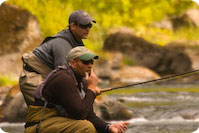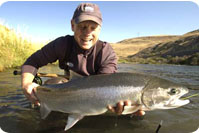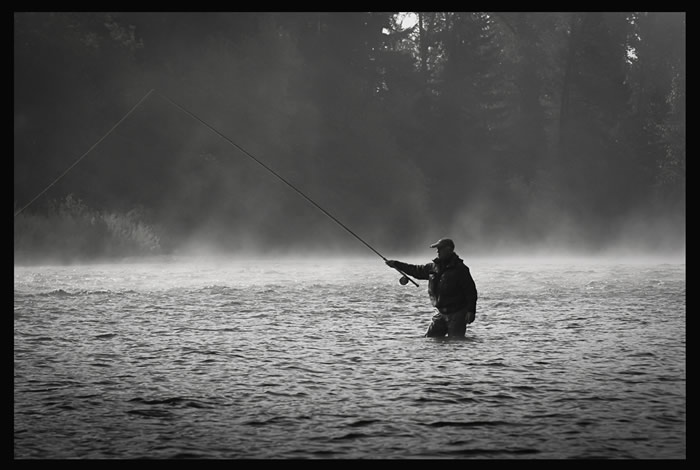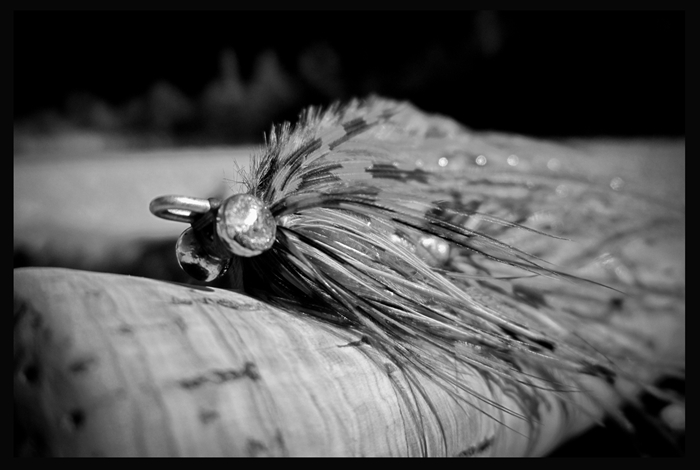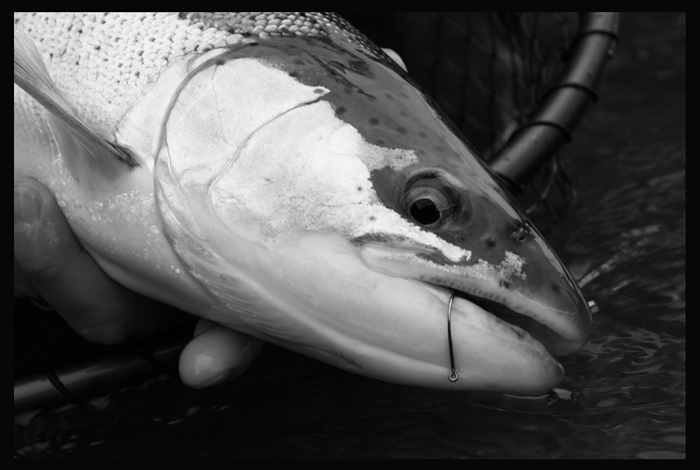By: Tom Larimer
Photo by Tom Larimer
One of the big challenges of winter steelheading is how quickly the water conditions and the attitude of the fish change. As an angler, you need to adjust your sink-tips accordingly. Given the fact that you get so little positive feedback as a winter steelheader, this is the most demanding aspect of the game. However, there are a few elements that can help you form an educated guess of what sink-tip to fish.
The biggest factor in sink-tip selection is the trend of the water flows. If the river is dropping right after a big winter storm, you can assume you’ll be fishing over fresh, aggressive fish. More times than not, the water will be high and have some stain to it in these conditions. In this situation the fish will hold in surprisingly skinny water, sometimes less than 2’, and very close to the bank. A long, heavy sink-tip will actually fish under the fish. Not to mention you’ll loose a ton of flies. This is the time to wade shallow, cast short and fish a light sink-tip. Also keep in mind that new fish are more willing to chase a fly swimming higher in the water column. -This is not the time to dredge the bottom! A great choice of sink-tip would be a 7.5’ MOW Tip in T-14 or a 10’ section of T-7 or T-10.
A couple of days after a storm, as the water drops and begins to clear, the migration of the fish will slow down. Consequently their willingness to hold in shallow water and their aggressiveness will change. You’ll want to fish more “tradition” 3’ to 5’ deep holding water in this situation. During this time the fish will still be fairly active but you’re going to need to get the fly deeper with mending and bigger sink-tips. A logical choice of sink-tip would be 12’ to 13’ of T-14 or T-10 during these circumstances.
Photo by Tom Larimer
One of the hardest times to catch winter steelhead is those periods during the winter when our rivers get low, clear and cold and we haven’t had a bump in the water level for a week or two. In these situations, there is little to no migration of existing fish in the system and new fish are hard to come by. The longer a steelhead sits in a river without migrating, the less aggressive it becomes. Usually they are very reluctant to move either laterally or vertically to intercept a fly. Plus, the fish will more than likely gravitate towards deeper holding water. This is especially true if the sun is out. This is the time to wade deep, fish your biggest sink-tips and blaze some big casts. You need to hit them on the nose so don’t be afraid to mend the fly hard and make your steps during the swing. -A wise angler fishes their fly deep and slow during the doldrums of winter. Make sure to layer up on your legs and feet because you’re going to wade deep! Although finding winter steelhead in low, clear, cold water is tough, your chances will go up if you have the right sink-tips. Make sure you’re carrying 12’ to 15’ of T-14 and T-18 for the low water times of the season. Sometimes getting the fly right in their face is the difference between casting practice and winter steelhead bliss.
If you’re ever in doubt of what sink-tip to fish or where to fish it, make one pass through a run wading shallow with a light tip. Make your casts short and concise and cover the shallow water near the bank. Then, make a second pass wading deeper with a heavier sink-tip. This is easy to do if you’re fishing with a partner.
Photo by Tom Larimer
Finally, always remember that if you’re loosing flies on every cast, you’re not fishing effectively. Steelhead don’t tip down to eat flies like a bonefish does. While the toughest conditions do necessitate getting the fly deep, most of the time active steelhead will be suspended 10” to 15”off the bottom. If the water you’re fishing is four feet deep and the fish is suspended a foot off the bottom, a fly swimming two and a half feet below the surface is right in their dinning room. One thing is for sure; you can’t catch a fish if you’re constantly tying on a new fly.
The next time you hit your favorite winter water, be observant of the situation, form a game plan, and take the time to change sink-tips accordingly. Make adjustments for each run you fish, the given conditions of the day and the attitude of the fish and you will find reward this winter.
About the author: Tom Larimer is a full time fly fishing guide from Hood River, Oregon. Outside of guiding he is one of the most respected Spey casting instructors in the country. Additionally he hosts destination trips, is a professional fly tier and works for Airflo Fly Lines.
|

